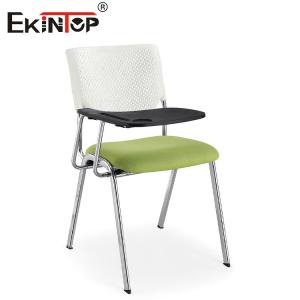

Add to Cart
Professional Training Room Chair with Convenient Writing Pad Modern Style
Product Description:
| Product Name | Professional Training Room Chair with Convenient Writing Pad Modern Style |
| Material: | Plastic and Fabric |
| Specific Use: | OFFICE CHAIR |
| Armrest: | Yes |
| Design Style: | Modern |
| Place of Origin | Guangdong, China, Guangdong, China (Mainland) |
Quick Details:
1:Testing and Comfort Trials: If possible, it is recommended to test and evaluate the comfort of training chairs before making a purchase. Many manufacturers offer comfort trials or showroom visits where you can try out different chair models to determine which ones best meet your comfort and ergonomic needs.
2:Manufacturer Reputation and Reviews: When choosing training chairs, it is beneficial to research the reputation and reviews of the manufacturer or brand. Look for manufacturers known for their quality craftsmanship, durability, and customer satisfaction. Reading customer reviews and testimonials can provide insights into the performance and durability of the chairs in real-world settings.
3:Training Chair Accessories: Various accessories can enhance the functionality and comfort of training chairs. These accessories may include writing tablets, cup holders, book racks, or integrated power outlets. Adding these accessories can further optimize the training experience and cater to specific training requirements, such as note-taking or device charging.
Features:
1. Integrated Storage Solutions: Some training chairs come with built-in storage solutions to enhance organization and convenience. These storage options can include under-seat compartments, side pockets, or rear storage racks. Integrated storage helps keep training materials, notebooks, or personal belongings within easy reach, reducing clutter and promoting a neat and organized learning environment.
2. Budget Considerations: Training chair prices can vary significantly based on factors such as brand, features, materials, and customization options. It is important to establish a budget and identify the key requirements before selecting training chairs to ensure the best value for investment.
3. Acoustic Properties: In spaces where noise can be a challenge, such as large training rooms or open-plan environments, some training chairs may incorporate acoustic properties. These chairs are designed to absorb sound and reduce echo, enhancing the overall learning experience by minimizing distractions and improving speech intelligibility.
4. Comfort Features: To ensure participant comfort during long training sessions, training chairs often include additional comfort features. These may include padded seat cushions, contoured backrests, and armrests. Some models also offer adjustable features, such as seat height and tilt, to cater to individual preferences.
Advantages:
1. Ganging and Cluster Seating: In training environments where collaborative or group work is common, ganging and cluster seating options can be beneficial. Ganging refers to chairs that can be connected together to form continuous rows or configurations, ensuring a cohesive seating arrangement. Cluster seating typically involves arranging chairs in circular or semi-circular configurations, allowing for easy interaction and discussion among participants.
2. Manufacturer and Product Warranty: When purchasing training chairs, consider the reputation and reliability of the manufacturer. Look for manufacturers with a track record of producing high-quality, durable chairs. Additionally, check the warranty provided with the chairs to ensure coverage for any potential manufacturing defects or issues that may arise.
3. Upholstery Options: Training chairs come in a variety of upholstery options to suit different preferences and requirements. Common upholstery materials include fabric, mesh, vinyl, or leather. Each material has its own advantages and considerations in terms of comfort, durability, maintenance, and aesthetics. Choose an upholstery material that is suitable for the intended use and matches the overall design scheme of the training space.
4. Pneumatic Height Adjustment: Many training chairs feature a pneumatic height adjustment mechanism. This mechanism allows users to adjust the seat height to their preferred level, providing ergonomic support and accommodating individuals of different heights. The adjustment is typically made by using a lever or a button located underneath the seat.
5: Linking Mechanisms: In training spaces where chairs need to be arranged in rows or connected together, some training chairs come with linking mechanisms. These mechanisms allow chairs to be securely linked side-by-side, preventing them from moving or separating during use. Linking mechanisms ensure a neat and aligned seating arrangement, particularly useful in lecture halls or large training rooms.
